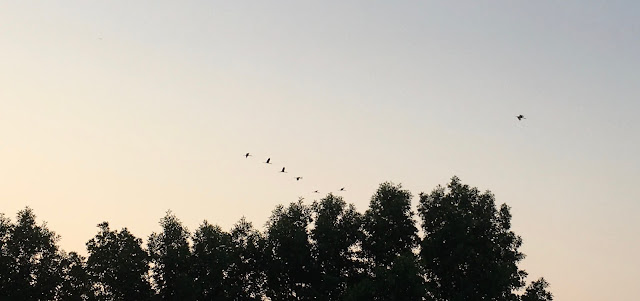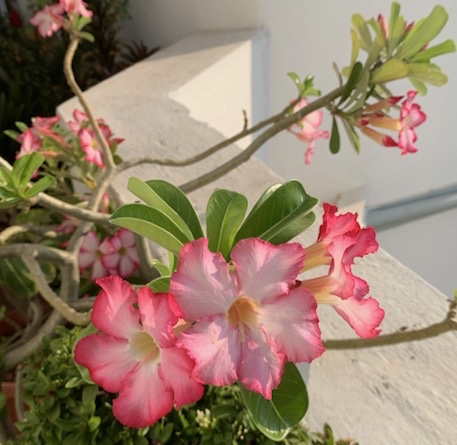23rd April 2020
Over the last few days, I have watched Chasing Coral on Netflix - no, it's not that long, just that I have watched in snatches - with awe, fascination, that changed to consternation and horror and finally ended with a feeling of misery and shame as to what we have done and what a screw up it all is.
The film is about the 2016 destruction of the Great Barrier Reef, and the great bleaching event that year, across the world, in oceans everywhere, putting the entire ocean ecosystem in peril.
In April 2017, we (MNS) made a memorable trip to the Andaman Islands, and this included a snorkelling morning off Havelock.
Seeing the picture brought back memories of that glorious morning, the shared delight of seeing those unknown marine creatures, the joy on my friend Raji's face at this whole new experience of ocean watching, the cool water under the strong April sun
I revisited the underwater pictures that one of the diving crew took and shared with us.
There had been much tectonic change in the region after the tsunami. However, as the ANET researchers were telling us, there had also been large-scale bleaching events as recent as 2016.
I read on their page that they now have a Citizen Science project REEF LOG. Indian waters and corals suffer from poor levels of documentation and research so this is a welcome effort.
Vardhan Patankar and a whole host of young scientists are also studying reef resilience in the Andaman waters - why some reefs seem more able to recover from bleaching events than others.
This may lead to better predictive models. "Coral stress is caused by an increase in sea surface water temperatures that remain above a specific threshold for three months. The threshold is usually one degree celsius above the highest summertime mean sea surface temperature for three months, or above four ‘degree heating weeks’ (DHWs), as this metric is called."
In the meantime, this year, there seems to have been another mass bleaching event this year on the GBR.
This is likely the last generation to see the Great Barrier Reef as humans have known it
Michael J. CorenApril 8, 2020
PS: The film has a shot of the Madras Marina beach (with a crow, scores of people and the lighthouse to boot), at bout he 65th minute.
Over the last few days, I have watched Chasing Coral on Netflix - no, it's not that long, just that I have watched in snatches - with awe, fascination, that changed to consternation and horror and finally ended with a feeling of misery and shame as to what we have done and what a screw up it all is.
The film is about the 2016 destruction of the Great Barrier Reef, and the great bleaching event that year, across the world, in oceans everywhere, putting the entire ocean ecosystem in peril.
In April 2017, we (MNS) made a memorable trip to the Andaman Islands, and this included a snorkelling morning off Havelock.
 |
| Sheila's picture of the beautiful day it was |
I revisited the underwater pictures that one of the diving crew took and shared with us.
 |
| From what I understood from the documentary, this then is dead coral - just back to being like a rock. Look at those beautiful fishes, |
 |
| One piece of agrophora(?) coral still holding on |
 |
| Honeycomb coral (I think) to the left, but on the right, that looks dead to me. |
 |
| And is this a bleaching coral? |
I read on their page that they now have a Citizen Science project REEF LOG. Indian waters and corals suffer from poor levels of documentation and research so this is a welcome effort.
Vardhan Patankar and a whole host of young scientists are also studying reef resilience in the Andaman waters - why some reefs seem more able to recover from bleaching events than others.
This may lead to better predictive models. "Coral stress is caused by an increase in sea surface water temperatures that remain above a specific threshold for three months. The threshold is usually one degree celsius above the highest summertime mean sea surface temperature for three months, or above four ‘degree heating weeks’ (DHWs), as this metric is called."
In the meantime, this year, there seems to have been another mass bleaching event this year on the GBR.
This is likely the last generation to see the Great Barrier Reef as humans have known it
Michael J. CorenApril 8, 2020
For 500,000 years, the Great Barrier Reef has grown steadily in the cool, clear waters off Australia. But after surviving five glacial periods, the reef’s billions of inhabitants may not survive humanity.
On March 26, the Reef endured its third major bleaching event in five years. Many of its corals sustained massive bleaching, even in the southern portion relatively untouched during the previous events, according to the Australian government. A rapidly warming climate has sent wave after wave of hot waters washing over the 3,000 individual coral reefs that make up the massive living structure, which stretches over 2,300 km (1,429 miles).
When water temperatures rise just a few degrees above normal, stressed corals may eject their symbiotic algae, leading to bleaching events. The bone-white corals are left without their life-giving partners. Some recover. But if bleaching occurs too often, and too intensely, the reefs die along with their ecosystem, often compared to a rainforest.
Sea surface temperatures, already 0.4 degrees Celsius higher than historical averages, are set to hit 2.5 degrees Celsius above normal by the end of the century. “Climate change remains the single greatest challenge to the Reef,” states Australia’s marine park agency.
Andrea Dutton, a paleoclimatologist at the University of Wisconsin-Madison, has spent her life studying this phenomenon. She drills into fossilized corals to see what they can tell us about the last few hundred thousand years of sea levels and ice sheets during bouts of global warming.
She spoke with Quartz twice over the past year to detail what today’s corals portend about the climate, and the significance of bleaching on the world’s largest coral system. Change, she knows, is part of life on the reef. But the pace now dwarfs anything that has come before. “It’s not that life can’t adapt,” she says. “But the question really is, can we still support human civilization, in a sustainable way on this planet. To do this, we need a healthy ecosystem around us…Not having healthy oceans is a profound risk to human civilization.”
Can you describe exactly what’s happening?
When the ocean heats up, symbiotic algae, the zooxanthellae [a yellowish-brown symbiotic dinoflagellate that lives in the coral and gives it color], can’t stay there anymore. And so they leave. And what’s left behind is just the coral skeleton, which is white. If you were to look at it from above, it completely changes the reef. All the color would be gone. The things that rely on coral to feed them also start to struggle.
And that’s what the corals look like in the fossil record. They’re just these white carbonate skeletons that I work with to try to understand what happened in the past.
If you had to analogize what’s happening to the reefs as if they were a human city, how would you describe that?
When a hurricane comes through and wipes out everything you need to live, it’s left in ruins. Things start to grow over it. You can’t imagine life being there anymore. That’s what’s happening to coral reefs, which are home to so many different organisms in the oceans.
When those corals don’t survive, they get covered with algae. This really slimy green yucky stuff. I’ve been diving on reefs that are covered with algae. It smells with all the dead organisms on the reef after the bleaching event. It was so upsetting I had to get out of the water. I couldn’t stay in it. It was absolutely horrifying to experience in person when you see what’s happening.
The problem is if you want to rebuild the reef, it’s not like rebuilding a city. If you had a whole bunch of money, you could go in there and build new buildings, and people could move in right away. For reefs, you could try to put in little recruits, little tiny coral colonies in there, and it would be so difficult to repopulate the entire reef. We would have lost species. A lot of those coral recruits wouldn’t survive anyway.
It’s not like we can just flip a switch and rebuild in the way that you can rebuild a city.Will the Lockdown help keep the ocean temperatures down this summer?
PS: The film has a shot of the Madras Marina beach (with a crow, scores of people and the lighthouse to boot), at bout he 65th minute.































